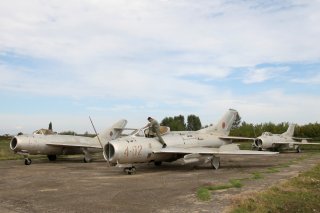The Storied History of North Korea's Soviet-Era Fighter Jet
North Korea is one of the few countries in the world today that still maintains a fleet of Soviet-designed MiG-19 planes.
Soviet aerospace engineers designed the MiG-19 to address significant problems inherent to the MiG-15 and similar MiG-17 fighter designs. Although the planes were notable for their agility at subsonic speeds, they both became unstable during flight in the transonic range, which is just above and below the speed of sound.
The MiG-19 fighter jet was intended to cope with the transonic and supersonic ranges better than its predecessors. It was also designed to have a better combat radius. It was “the first Soviet production fighter capable of supersonic speeds in level flight,” according to the U.S. Air Force.
Engineers equipped the MiG-19 with updated engines to achieve these goals. Together, the engines produced about double the amount of thrust as the previous MiG-17 did, which was a significant improvement. The new MiG-19 fighter had four hardpoints to which both fuel and munitions could be attached. However, two of the four hardpoints could only be paired with fuel, somewhat limiting the MiG-19’s weapon loadout.
What the fighter lacked in bombs and rockets it made up for with guns: three enormous thirty-millimeter autocannons. These guns would provide pilots with a considerable advantage over opposing pilots, particularly in the early years of the Vietnam War.
In the early years of the Vietnam War, many new American fighter jets lacked any onboard guns due to the incorrect assumption that dogfights would occur entirely from distant ranges. Before that conflict, American aerospace engineers assumed that the prototypical World War II aerial dogfights would be unlikely to happen at supersonic speeds.
The Shenyang J-6
The U.S. Air Force maintains that “possibly as many as 10,000 MiG-19s, in various versions, were built by the Soviet Union, China, Poland and Czechoslovakia. Many other countries used the MiG-19, including Cuba, North Vietnam, North Korea, Iraq, and most of the Warsaw Pact nations.”
China was one of the most significant MiG-19 customers, but they called the fast little jet by another name.
Before the Sino-Soviet split, which severed relations between communist China and the Soviet Union, both countries were quite close. During that relationship’s golden years, the Soviet Union exported a great deal of material to the Chinese comrades, particularly military technology and equipment—the MiG-19 is a prime example.
Chinese engineers reverse-engineered the little MiG, allowing China to build its own planes domestically, though under the Shenyang J-6 name. Given the jet’s simplicity and price-point, today, North Korea is one of the only countries that uses the jet. North Korea maintains a fleet of approximately 100 J-6 airframes to this day.
Caleb Larson is a multimedia journalist and defense writer with the National Interest. A graduate of UCLA, he also holds a Master of Public Policy and lives in Berlin. He covers the intersection of conflict, security, and technology, focusing on American foreign policy, European security, and German society for both print and radio.
Image: Reuters.

